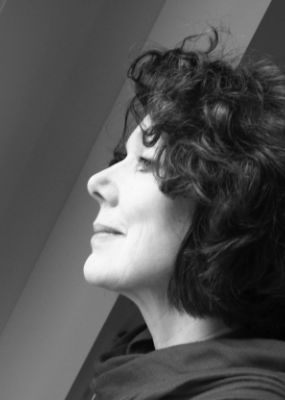CAROL ANDERSON
APRIL 2011
DANCE HISTORIAN OF THE MONTH
INTRODUCTION
Welcome to DCD’s “Dance Historian of the Month” – a series that features interviews with Canada’s dance historians. We hope to illuminate aspects of the person, their craft, the field, and to provide insight into what inspires those who interpret our dance pasts. The interview is accompanied by a photo, giving a face to the bylines. Often veiled by computer screens, untouched by stage lights and represented only by their printed words, historians are the intangible forces that spur dance on. Our interview is your introduction to the historian herself.
Carol Anderson was a founding member of Dancemakers in 1974 and she performed with the modern dance company for 15 years. She acted as the company’s artistic director from 1985-1988 and choreographed notable works such as Windhover (1983) and Polyhymnia Muses (1988). Anderson started her performing career with Judy Jarvis’s first company; she has also collaborated with Toronto Independent Dance Enterprise, and she continues to choreograph for the Canadian Children’s Dance Theatre. Her choreography has been televised, shown internationally, and has been nominated for three Dora Mavor Moore Awards. She has also published 9 key Canadian dance books including Rachel Browne: Dancing Toward the Light (1999) and Unfold: A Portrait of Peggy Baker (2008). Anderson is an Associate Professor in York University’s Dance Department and is currently on sabbatical. During her time away from teaching, Carol is busy developing her research and writing, studying a movement technique called Gyrokinesis, and performing in the Older and Reckless series. Carol is also responsible for the Choreographic Dialogues featured on DCD’s website.
Carol’s diverse and successful dance projects make evident her significant contribution to Canadian dance. She is a perceptive and elegant artist; I hope our interview reveals her eloquence
Sincerely,
Carolyne Clare
DCD Metcalf Foundation Intern
INTERVIEW

Name: Carol Anderson
Place of birth: Regina, SK
Current Employer: Professor, York University Department of Dance (on Sabbatical)
CC: Why did you start to dance?
CA: I come from a musical family. My mother was a music teacher and all my sisters played the piano. I refused to practice the piano so my mother stopped teaching me, but I always had this very immediate and physical response to music. Certain pieces of music would send me into a trance-like state. My connection to music and rhythm led me to dance.
In Regina, during the 1950s, my only options were to study tap or ballet. On Saturday mornings, I used to hike up the street in my ballet slippers to get to the local public school for dance classes. We learned the Royal Academy of Dance syllabus, and my teacher’s name was Eileen Carnrike. I later learned that she was one of those solitary, intrepid dance teachers who brought ballet to the West.
CC: What led you to start dancing professionally?
CA: When I went to Queen’s University, I studied English, French, history and drama; a comprehensive liberal arts education. At that time, Judy Jarvis was an artist-in-residence at Queen’s. She had recently come back from the Wigman School in Berlin. Even though she was essentially a solo artist, she was determined to gather a group of dancers around her. That was the Wigman model: a Dance Group. Our dance group was a gang of about 6-8 young women, who met in the gym on Wednesday evenings. We did improvisations and a lot of breathing.
While still at Queen’s, another young woman and I performed with Jarvis at the National Arts Centre. After two years at Queen’s, I left to work with Jarvis’s first company. We did a huge number of shows in public schools and we worked towards presenting public evening performances. That was my first professional dance experience.
CC: Can you tell me more about completing your undergraduate degree?
CA: While I was dancing with Jarvis’s company, the dance department at York University was just starting up. The founding chair of the department, Grant Strate, very kindly allowed me to take technique classes with the students in the morning. Although my parents lived in Etobicoke, I got myself up to York every morning to take class. During the afternoon, I would sometimes go to the music library to listen to electronic music. By 5:00 pm, I’d head to Jarvis’s studio for a second technique class, and we’d rehearse until 10:00 pm several nights a week.
When Jarvis’s company scattered, I decided to return to university. I was permitted to complete my course work at York. I only had one science credit to complete, and so for most of the two-year period I took only dance courses. It was actually very nice.
CC: What was York University’s dance department like at its start?
CA: The program was very rich in resources. York’s Burton Auditorium was a magnet for touring companies. I can remember seeing the Merce Cunningham Dance Company, the Paul Taylor Dance Company (including a very young Danny Grossman), José Limón Dance Company and others. The teachers were also amazing. Ahuva Anbary, a formidable former Batsheva dancer, was our exacting Graham teacher. We also had guest teachers from the Martha Graham Dance Company and from the London School of Contemporary Dance. My academic teachers, such as Selma Odom, were also fantastic. Overall, when I walked into the York program, the level of rigour was impressive. The program did not start at the ground up; it seemed that the best of the dance world was at York. It was a thrill for the students to try to ascend to that level of work.
CC: When did you start writing about dance?
CA: After a long run of performing, choreographing and directing, I found it necessary to take on a new role in the dance milieu. I was astonished when I retired at how quickly that door just shut. When you leave the stage, the door doesn’t close behind you – it slams. It wasn’t only me; I also saw it happen to other dancers.
I did feel pressure to transition; however, I didn’t step off the stage and exclaim, “I’m going to become a dance writer.” It was more circumstantial. One day, I went over to Dance Collection Danse to speak to its founders, Lawrence and Miriam Adams. I told them that I wanted to write a book about Judy Jarvis. They said, “Oh really?” and they showed me all of their boxes of her archives that were sitting in the living room. It was that casual. The start of my writing dovetailed with the beginning of their publishing. I was very fortunate. They supported me in most of my projects. They were just wonderful to me.
I must confess that I developed book lust. When dancing and choreographing was no longer my only focus, I longed to have something that I could hang onto, as a tangible product of my work. Dance is ephemeral; by contrast, books endure. Whenever Lawrence Adams finished working on a book, he would drop it on the floor. In some way that “thunk” would verify that it had become a material and weighty object. Having a tangible product motivated me to write.
CC: What genre of dance writing do you create?
CA: I don’t really think of myself as an historian, but as a chronicler. I am not trained as an historian. I do historical research but that is not my primary mode. In my writing, I especially like creating opportunities for artists to speak. My book, This Passion: for the love of dance allows dancers to write about other pivotal dancers. The book provides a testimony to ephemeral and outstanding Canadian dance work.
CC: Do you use your body as part of your writing process?
CA: Absolutely, yes. I discovered that it is easier for me to write about a performance when I allow my body to inform my words. Dance affects us profoundly; a performance influences the way my body feels and perceives space. While writing about a performance, if I tap into my body’s experience of the choreography, then I can more easily discover its meaning and poetry.
CC: Which dance writers do you like to read?
CA: Some of my favourite dance writers have been Deborah Jowitt, Marcia Siegel, Agnes de Mille and Jill Johnston. I enjoy biography because I am more practical than theoretical. However, I appreciate deep, beautiful theory. I also read a lot of newspaper and magazine articles. The Dance Current certainly keeps us ticking; it is always rich and full.
While I was dancing, I took in most of my information through moving and watching performances instead of by reading. Performing is a different preoccupation; when you are consumed by dance, you are too tired to read – at the end of a day, you crash. However, literature has informed my work. For example, one of the pieces I choreographed, Time and Fevers (1988), is based on one of W.H. Auden’s poems.
CC: Do you think today’s young choreographers feel more pressure to refer to dance history?
CA: There is simply more history now, so it’s in everyone’s interest to know more. Watching dance, especially contemporary dance, I sometimes feel that we are reinventing the wheel. If choreographers know more about our history, they may be able to be more innovative. However, it is difficult for performers and choreographers to study history while also maintaining their technical proficiency and loaded performance schedules.
CC: Would you recommend that young dance artists work more closely with senior artists so that they don’t reinvent the wheel?
CA: No. You should let us retire! I’m joking. Actually, as I’ve said, I think it is the responsibility of more senior artists to ensure that young artists have access to their history. A documentation project, such as Peggy Baker’s Choreographer’s Trust, is a shining example of how dance can be passed on from one generation to the next. There are other notable dance legacy projects such as Vincent Warren’s library at l’École supérieure de ballet contemporain, Coleman Lemieux & Compagnie’s restaging of James Kudelka’s ballets, Mary Jane Warner’s project to record outstanding Canadian choreography, Danny Grossman’s work to preserve and license selected pieces from his repertoire, and La Fondation Jean-Pierre Perreault’s careful documentation of Perreault’s dances in order to enable reconstructions. These projects facilitate artists’ use of dance history.
CC: What does dance history contribute to dance?
CA: Dignity. Dance history puts into perspective the social and political component of dance. Dance in a way symbolizes how we live in our bodies. It is also a physical expression of various social forces that are at play.
The Canadian dance milieu is deepening its engagement with dance studies and dance as a cultural study. However, that kind of research is not in all dance artists’ vision. Not all dancers get to study history. I think, at its best application, dance history informs dancers about what they are practicing. Dance history can broaden a dancers’ perspective on their art, and their work can become something other than striving for high kicks and multiple pirouettes. History can provide dancers with a different feeling of what they are involved with.
CC: You have written about many amazing women such as Peggy Baker, Rachel Browne, Judy Jarvis and others. Do you approach your own work as being feminist?
CA: I’d say I approach my work as being matriarchal rather than feminist. Dance is a difficult, even a mad, career. It is physically, emotionally, psychologically and even organizationally challenging. The women I have written about have prevailed over these challenges. These women have extraordinary drive; they tackled the difficult situations they often found themselves in and found a way forward. For many of them, it was very difficult.
I am interested in how female dancers house knowledge and determination. I am fascinated by how that knowledge is passed on through generations of dancing women. How are young dancers mentored and how do moving bodies transmit knowledge?
I think back to the great dance mothers: Isadora Duncan, Martha Graham, Doris Humphrey, Mary Wigman, Pina Bausch … they continue to be influential. I feel that these iconic dancers have a kind of goddess quality to them. Their innovative dancing systems are not only inspirational, recalling their power and personas is like a throw back to goddess times.
CC: If you could travel to an era of dance past where would you go?
CA: There are a couple of things I would love to do. Not very long ago dancing was a common aspect of daily life. Some Torontonians went to balls and people danced in social settings regularly. I would like to waltz at a ball in the Grange (at the Art Gallery of Ontario) in the 1850s. Imagine the waltz being immoral! Balls must have been exciting.
I would also like to dance with one of those early iconic female modern dancers. No one had ever done what they were doing. I have always been fascinated by Mary Wigman, by her incredible intelligence, her intensity, and her darkness. I’d also dance with Doris Humphrey. I love her musicality and the pulse breath and her use of weight. Her work is deeply humanistic; it is passionate and compassionate. I love it.
CC: Do you have any concluding thoughts?
CA: I think there is a cornucopia of really great work going on. There are many different areas being investigated. I feel lucky because I get to see that work happen. I like working closely with young dancers and scholars. It’s exciting. I also think that Canadian dance is continuing to blossom, in its incredible diversity, and at many levels. Especially in the realm of Canadian dance preservation and scholarship, work is really taking off. I’m encouraged.
PUBLICATIONS
- Judy Jarvis: Dance Artist: A Portrait (Dance Collection Danse Press/Presses, 1993)
- This Passion: for the love of dance (contributing ed.) (Dance Collection Danse Press/Presses, 1998)
- Chasing the Tale of Contemporary Dance, Part 1 and Part 2 (Dance Collection Danse Press/Presses, 1998/2001)
- Rachel Browne: Dancing Toward the Light (J. Gordon Shillingford, 1999)
- Lunch with Lady Eaton: Inside the Dining Rooms of the Nation (co-authored with Katherine Mallinson) (ECW Press, 2004)
- Reflection in a Dancing Eye: Investigating the Artist’s Role in Canadian Society (co-ed. with Joysanne Sidimus) (Banff Centre Press, 2006)
- Unfold: A Portrait of Peggy Baker (Dance Collection Danse Press/Presses, 2008)
- LOLA DANCE Lola MacLaughlin: A Life in Dance (contributing ed.) (LOLA DANCE, 2010)
PERSONNEL
Miriam Adams, C.M.
Co-founder/Advisor
Amy Bowring
Executive and Curatorial Director
Jay Rankin
Administrative Director
Vickie Fagan
Director of Development and Producer/Hall of Fame
Elisabeth Kelly
Archives and Programming Coordinator
Michael Ripley
Marketing & Sales Coordinator
CONTACT
1303 – 2 Carlton St.
Toronto, ON
M5B 1J3
Canada
Phone: 416-365-3233
Fax: 416-365-3169
info [AT] dcd.ca
HOURS
Mon. – Fri. 10 a.m. – 5 p.m.
Appointment Required
Contact our team by email or call one of the numbers above







